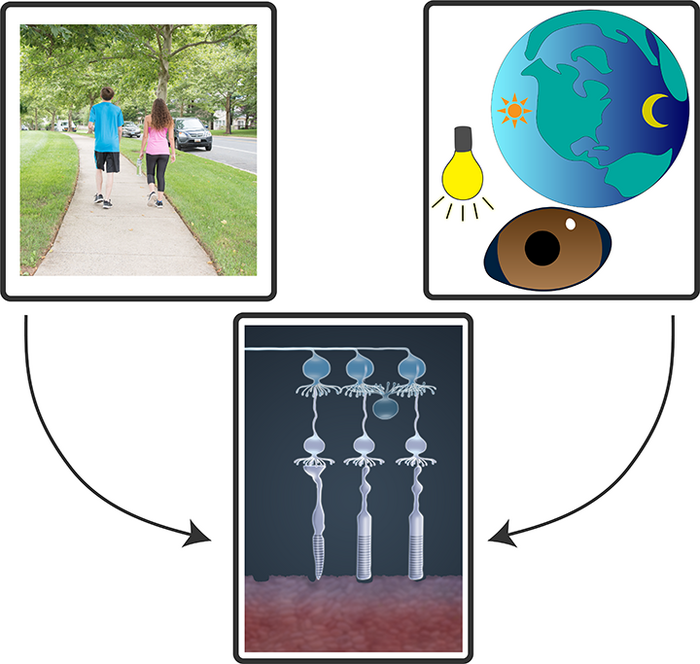The eye’s light-sensing retina taps different circuits depending on whether it is generating image-forming vision or carrying out a non-vision function such as regulating pupil size or sleep/wake cycles, according to a new mouse study from the National Eye Institute (NEI) and the National Institute of Mental Health (NIMH). The findings could have implications for understanding how our eyes help regulate mood, digestion, sleep, and metabolism. NEI and NIMH are part of the National Institutes of Health.

Credit: National Eye Institute
The eye’s light-sensing retina taps different circuits depending on whether it is generating image-forming vision or carrying out a non-vision function such as regulating pupil size or sleep/wake cycles, according to a new mouse study from the National Eye Institute (NEI) and the National Institute of Mental Health (NIMH). The findings could have implications for understanding how our eyes help regulate mood, digestion, sleep, and metabolism. NEI and NIMH are part of the National Institutes of Health.
“We know a lot about pathways involved in image-forming vision, but until now it remained unknown if and how non-image-forming visual behaviors rely on these same pathways in the eye,” said Johan Pahlberg, Ph.D., head of the Photoreceptor Physiology Group at NEI and a senior author of the study.
Vision begins when light travels into the eye and hits the retina’s light-sensing photoreceptors. The photoreceptors transfer signals through several layers of retinal neuron before those signals are sent to the brain. Light also triggers certain non-vision functions, such as controlling how much light enters the eye through the pupil (pupillary light reflex) and regulating the wake/sleep cycle (circadian rhythm). Circadian rhythm disruption has been linked to sleep problems, obesity, and other health issues.
To investigate pathways used by image-forming versus non-image-forming functions in the retina, Pahlberg and colleagues studied groups of mice that had been genetically modified to turn off one or more pathway links, or synapses, between photoreceptors and their next downstream neuronal neighbors, called bipolar cells. The group investigated the roles of rod photoreceptors, which are sensitive to low light levels; cone photoreceptors, which see color; as well as three types of bipolar cells: rod bipolar cells, “on” cone bipolar cells, and “off” cone bipolar cells.
“On” cone bipolar cells react to increases in light, and “off” cone bipolar cells react to decreases in light. Cone photoreceptors can only communicate with cone bipolar cells, while rod photoreceptors have pathways to communicate with each of the bipolar cell types, depending on the level of light. Bipolar cells then communicate with other neurons in the retina, passing information to the optic nerve and on to the brain. Some mice in the study had no functional connections between rods and “on” bipolar cells, for example, or connections between cones and any bipolar cells, or lacked connections between rod and cone photoreceptors.
The researchers compared the mice’s responses to visual stimuli while assessing pupillary light responses and monitoring their nocturnal wake/sleep cycle. They determined that while image-forming vision can use rod and cone photoreceptors, as well as all the types of bipolar cells, the same was not true for non-image forming functions. The pupil response relies exclusively on rod photoreceptors, while cones are unable to control this behavior. Meanwhile, both circadian rhythm regulation and the pupil reflex only use “on” bipolar cells pathways, relying on rod bipolar cells and “on” cone bipolar cells, but not “off” cone bipolar cells.
“We were really surprised to find that animals with only ‘off’ bipolar cells can’t adjust to changes in the day/night cycle, but can still see and respond to visual events, meaning they have functional image-forming vision. It was really interesting to us that the non-imaging forming functions completely ignore information from the ‘off’ pathway,” said Pahlberg. “We were equally surprised that rod photoreceptors, which are optimized for low light conditions, were still being used for the pupillary response even when light levels were high. We really thought the rods would be maxed out at that point.”
Pahlberg expects many of these findings in mice will hold true for humans, since the retinal circuitry is similar across mammals. Moving forward, he intends to explore other non-image-forming functions of the retina, like mood regulation, and see how else these different retinal circuits are being used.
The research was funded by the intramural programs of NEI, NIMH, the National Institute of Dental and Craniofacial Research, and the National Institute of Neurological Diseases and Stroke.
Reference: Beier C, Bocchero U, Levy L, Zhang Z, Jin N, Massey SC, Ribelayga CP, Martemyanov K, Hattar S, and Pahlberg J. “Divergent outer renal circuits drive image and non-image forming vision.” Cell Reports. June 28, 2022. https://doi.org/10.1016/j.celrep.2022.111003
###
This press release describes a basic research finding. Basic research increases our understanding of human behavior and biology, which is foundational to advancing new and better ways to prevent, diagnose, and treat disease. Science is an unpredictable and incremental process— each research advance builds on past discoveries, often in unexpected ways. Most clinical advances would not be possible without the knowledge of fundamental basic research. To learn more about basic research, visit https://www.nih.gov/news-events/basic-research-digital-media-kit.
NEI leads the federal government’s research on the visual system and eye diseases. NEI supports basic and clinical science programs to develop sight-saving treatments and address special needs of people with vision loss. For more information, visit https://www.nei.nih.gov.
About the National Institutes of Health (NIH): NIH, the nation’s medical research agency, includes 27 Institutes and Centers and is a component of the U.S. Department of Health and Human Services. NIH is the primary federal agency conducting and supporting basic, clinical, and translational medical research, and is investigating the causes, treatments, and cures for both common and rare diseases. For more information about NIH and its programs, visit https://www.nih.gov/.
NIH…Turning Discovery Into Health®
Journal
Cell Reports
DOI
10.1016/j.celrep.2022.111003
Method of Research
Experimental study
Subject of Research
Animals
Article Title
Divergent outer renal circuits drive image and non-image forming vision
Article Publication Date
28-Jun-2022




